By Ebrahim Mahdawi
Nahoor in Ghazni province is picture postcard pretty. With plentiful water from streams and rain, it is green. There are orchards of apricots, plums, prunes and other fruit. Three decades ago it was the site of a bloodbath. A testimony*
Seventy-year-old Abdul Husain is a witness. From Deh Afghan, a village in Nahoor district, he says the scars left by war have not healed. There are families who don't know what happened to loved ones, while in village after village, the many physically challenged survivors are daily reminders of the bombings and killings.
"The murdered people were all my relatives - one of my brothers, four cousins and so many others," says Husain.
Nahoor with its majority Hazara population was on the frontline of the war between Soviet soldiers and mujahedin. Power in Kabul rested in the hands of Babrak Karmal, the third communist party president. Nahoor was the first district the Afghan fighters had wrested from the "Russians" as the Soviets were called. The Soviet army bombarded Nahoor from the air and with heavy artillery.
Terror everywhere
According to Husain, who is also known as Malak Abdul, even people in remote and mountainous areas of Nahoor were not safe from Russian "barbarity". The terror was everywhere. There was no peace for civilians. Those who objected were tortured, and thrown in prison.
The worst year was 1981, two years after the Soviet army rolled across the border into Afghanistan. Russian soldiers tried to fight their way into Nahoor through the Qeyagh pass. They bombed Der Afghan and Sokhta Alawdani, the two villages closest to the border. Malak Abdul says his elder brother Malak Janali was martyred.

In this April 1988 photo, Soviet soldiers observe the highlands, while fighting Islamic guerrillas at an undisclosed location in Afghanistan. (Photo: Estate of Alexander Sekretarev/AP/File)
Russians entered people's houses, and stripped it of all belongings. Buildings were demolished. Families fled the fighting and killing. The only people who remained were the mujahedin. "I also took my family to a safe area hoping to come back when it was safe," says Husain.
While his younger brother and his family left, his elder brother and relatives stayed to defend the village. "My brother knew the Russians were coming but he was not aware they had already entered the village. He tried to save himself by moving to Ghara, a village adjacent to ours. But he did not make it," he says.
Husain and his brother, their families and others from the village, kept walking. But there was no escaping the whine of fighter planes and pounding of shells. "It was terrifying. We did not know how to get away. We decided to go to the Siah Qul area where we thought it would be safer and out of the enemy's line of firing," he says.
Gunned down
One kilometre short of Siah Qul, a barren valley in the desert, the Soviet soldiers caught up with the fleeing civilians. "There was one kilometre to get to Siah Qul. Suddenly the desert erupted with the sound of tanks. The Russians had besieged the desert. We didn't know the mountains above Siah Qul were the hideout of mujahedin," says Husain.
Russian tanks trained their guns on the winding procession of fleeing civilians. There was a bloodbath. Only those who ran up the mountainsides survived.
"We were still in the middle of the desert when the Russian tanks started firing toward us from three sides. We ran as fast as we could toward Sia Qul valley. The only hope of escape lay in going into the mountains where the mujahedin were hiding," he recalls.
Husain paused for a long while before speaking again. "My brother Jan Ali and some others were running helter skelter to save themselves. The group had scattered. But no one was able to save themselves. Russian tanks got them all in the end," he says.
Sole survivor
The first one to go down was a relative called Sultan. "A shot first got him on the leg. Sultan went down. He was screaming. The Russians had no pity. They sprayed him with bullets," he says. Bodies littered the ground. Husain cannot fathom how come he was the only person who escaped.
"The invaders killed all of them. They fired hundreds of shots," he says, his eyes well up with tears.
Meanwhile, back in Sokhta Alawdani, the Soviet soldiers retreated after 24 hours. "The Russian invaders left the village after one day and night stay in Sokhta Alawdani. Men started trickling back to the village. Women and children stayed away because there was still the possibility of the Russians returning. We gathered together all the bodies of the dead. We decided to bury the martyrs in one place. We buried them on a hill called Tapa e Karez. It wasn't a graveyard. The hill is called the hill of martyrs," he says.
The Russians never came back to Nahoor. It remained in mujahedin hands until the Soviet army pulled out of Afghanistan.
** The testimonies of survivors of war crimes are our contribution to creating greater public awareness about people's hopes and claims for justice, reconciliation and peace. These testimonies and life stories are distributed internationally by the news agency IPS-Inter Press Service and are the basis for a radio drama that is being broadcast by seven Killid radios.



